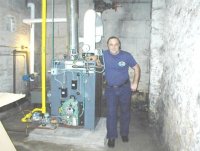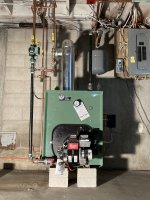Is there any disadvantage for installing a new boiler on blocks, maybe 4 inches high? My concrete basement floor is perfectly flat and dry, but the new boiler has an inlet close to the floor, and as long as I'm going to change it, it might be easier to work on if it was up in the air a bit.
My plan was to buy some solid 4X8X16" concrete blocks and use some thinset mortar to adhere the blocks to the floor and to each other. I do NOT want to pour a base.
I did Google the issue and saw a lot of conflicting information about combustion mixture changing if the boiler is raised, but I don't see how this would happen on an oil fired burner (Beckett AFG). This will be a SlantFin that has the firebox encircled with a water jacket, so the bottom of the boiler is relatively cool if that makes any difference.
John
My plan was to buy some solid 4X8X16" concrete blocks and use some thinset mortar to adhere the blocks to the floor and to each other. I do NOT want to pour a base.
I did Google the issue and saw a lot of conflicting information about combustion mixture changing if the boiler is raised, but I don't see how this would happen on an oil fired burner (Beckett AFG). This will be a SlantFin that has the firebox encircled with a water jacket, so the bottom of the boiler is relatively cool if that makes any difference.
John


